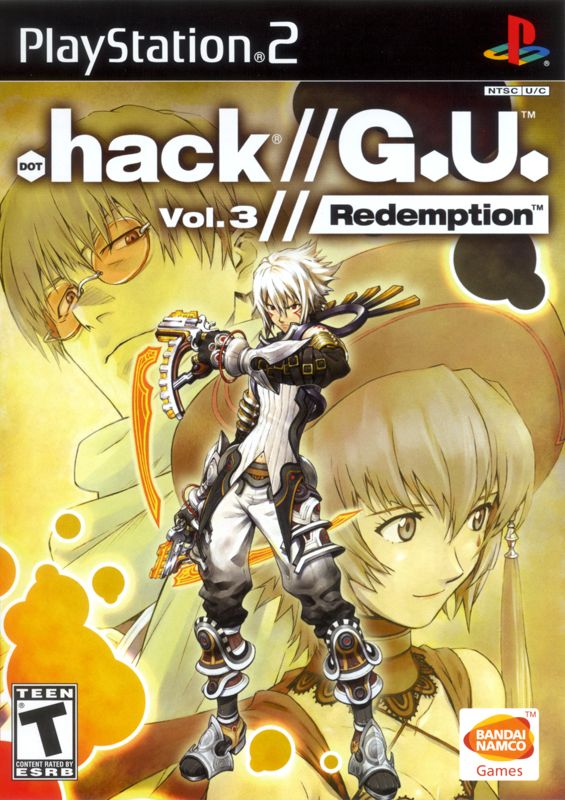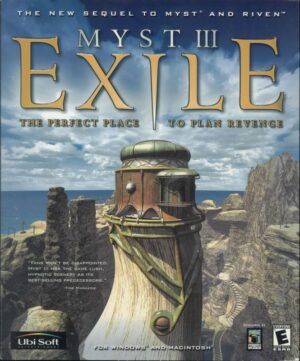Retro Replay Review
Gameplay
.hack//G.U. Vol. 3: Redemption picks up the core real-time battle system established in the previous volumes and refines it with new layers of strategy. Encounters begin the moment Haseo collides with an enemy in The World, triggering fast-paced skirmishes that keep you on your toes. The introduction of Avatar Awakening lets Haseo tap directly into his Avatar’s power, opening up Data Drain attacks that are as visually striking as they are effective against AIDA-infected foes.
(HEY YOU!! We hope you enjoy! We try not to run ads. So basically, this is a very expensive hobby running this site. Please consider joining us for updates, forums, and more. Network w/ us to make some cash or friends while retro gaming, and you can win some free retro games for posting. Okay, carry on 👍)
The familiar trio setup returns, with Haseo at the helm and two AI-controlled allies following your simple command inputs. While you focus on unleashing combo chains and charging up for Rengeki strikes, your party members contribute with supportive attacks or buffs. Setting attack patterns and keeping an eye on your morale gauge becomes crucial, especially when you’re aiming to trigger the powerful Awakening Mode attacks that can turn the tide of tougher boss fights.
Beyond the core combat, Vol. 3 offers a wealth of missions, side quests, and optional dungeons. Whether you’re hunting rare enemies for loot, racing against the clock in special trials, or simply exploring familiar zones refreshed with new enemy types, there’s never a dull moment. Transferring data from Volumes 1 and 2 provides useful bonuses—extra levels, items, or unlocked skills—rewarding series veterans and giving newcomers a motivation to dive into the entire trilogy.
Graphics
On the PlayStation 2 hardware, Redemption delivers a vibrant, anime-inspired aesthetic that captures the digital world’s whimsical charm. Character models are sharp and expressive, while the color palette shifts dynamically between safe towns, luminous forests, and the eerie depths of data-corrupted dungeons. Texture detail holds up remarkably well, even if we occasionally notice the era’s signature low-resolution backgrounds up close.
In-game cinematics blend seamlessly with gameplay, enhancing immersion as you watch Haseo’s transformations and pivotal story moments unfold without jarring visual transitions. Special effects—particularly those associated with Avatar Awakening and Data Drain sequences—are fluid and flashy, lending a sense of importance to each key battle. Frame rate dips are rare, occurring mainly when multiple particle effects converge on-screen.
The user interface remains clean and intuitive. Health bars, skill cooldowns, and mission objectives are clearly displayed without cluttering the view. Inventory screens and message boards evoke the feel of logging into a real MMORPG, complete with in-game mail notifications and digital signage. All told, Redemption pushes the PS2 a bit further, delivering a polished presentation that fans of the series will appreciate.
Story
Redemption picks up immediately after the cliffhanger ending of .hack//G.U. Vol. 2, continuing Haseo’s quest to eradicate the AIDA virus from both The World and the real world. As the final chapter of the trilogy, it dives deep into unanswered questions about the nature of Avatars, the fate of Tri-Edge, and the true identity behind the malevolent force threatening everyone online.
Narrative delivery feels authentically MMO-esque, with plot points revealed through a combination of cinematic cutscenes, in-game emails, and posts on The World’s message boards. This layered storytelling approach immerses you in the virtual environment, blurring the line between player and character. New companions and old allies reappear, each contributing their own perspective and forging emotional stakes that pay off in the climactic finale.
While returning fans will savor callbacks to Volume 1 and 2—locations revisited, dungeons reimagined, and in-jokes aplenty—newcomers might find the lore dense at first. A brief recap or guided data import helps, but it’s ultimately a conclusion best appreciated by those invested in Haseo’s journey from the beginning. By the end, Redemption delivers a satisfying sense of closure, resolving long-standing mysteries and character arcs with heartfelt poignancy.
Overall Experience
As the capstone of the .hack//G.U. trilogy, Vol. 3: Redemption stands out as a fitting conclusion that marries refined gameplay with emotional storytelling. The addition of Avatar Awakening revitalizes combat, keeping encounters fresh even after dozens of hours. Side content and data-transfer bonuses encourage replayability, making it a must-play for RPG enthusiasts who value depth and customization.
The world design strikes a balance between nostalgia and innovation: familiar zones from earlier games feel newly alive, while fresh dungeons and enemy types ensure you’re never retracing old ground without purpose. Performance hiccups are minimal, and the cohesive integration of narrative with gameplay mechanics underscores the series’ unique charm.
Ultimately, Redemption may challenge newcomers with its lore-heavy premise, but for fans of the franchise it delivers an unforgettable finale. Haseo’s evolution from a solitary hunter into a hero confronting the very fabric of the digital realm makes this journey worth undertaking. Whether you’re driven by the thrill of real-time combat, the allure of a sprawling MMO setting, or the desire for narrative closure, .hack//G.U. Vol. 3: Redemption offers an engaging, polished, and emotionally resonant experience.
 Retro Replay Retro Replay gaming reviews, news, emulation, geek stuff and more!
Retro Replay Retro Replay gaming reviews, news, emulation, geek stuff and more!




Reviews
There are no reviews yet.